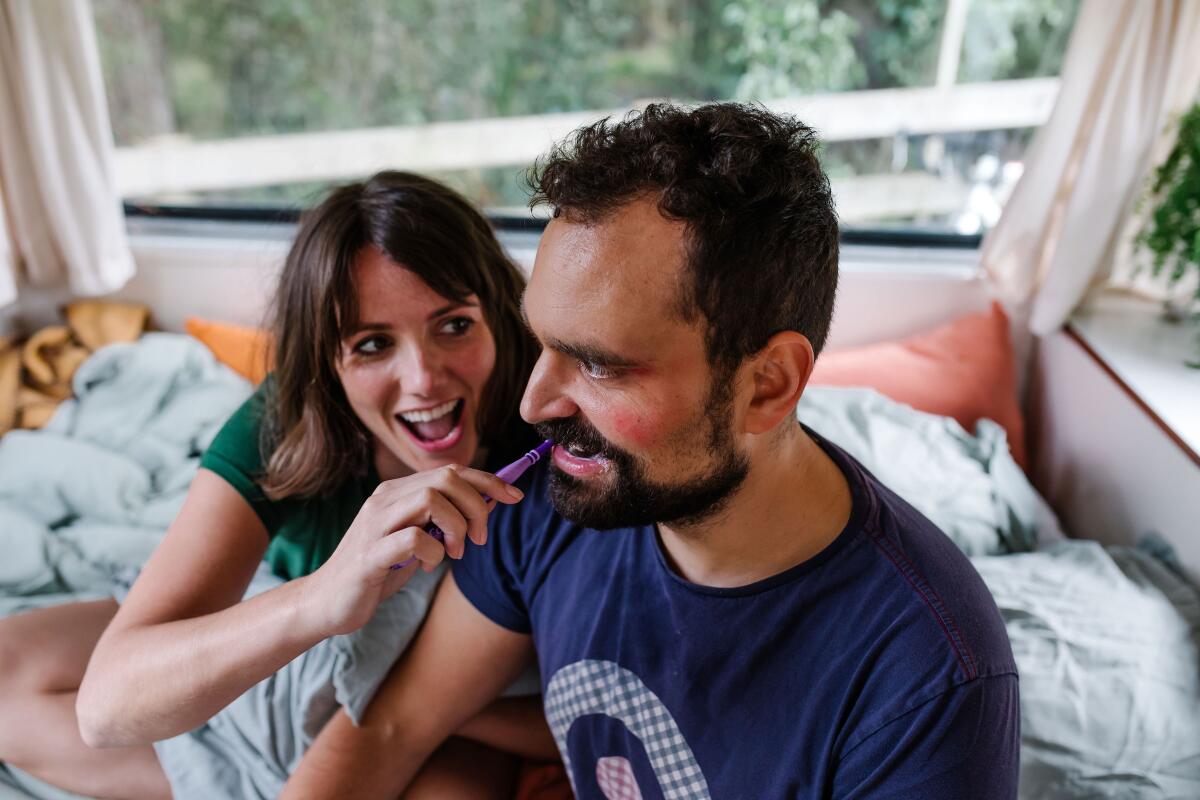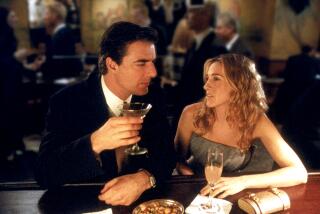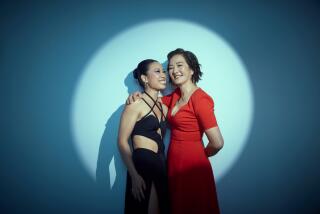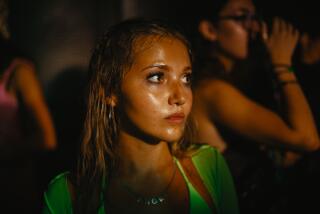Here’s how HBO Max doc ‘There Is No “I” in Threesome’ pulled off the shocking twist

Warning: The following article spoils significant details of the HBO Max documentary “There Is No ‘I’ In Threesome.”
Did you fall for it, too?
Because I did. I totally bought that “There Is No ‘I’ in Threesome” was just going to be a straightforward documentary about a newly engaged couple testing the boundaries of an open relationship.
Yes, I got the sense that the experiment was a terrible idea — that the filmmaker, Jan Oliver Lucks, and his fiancee, Zoe, might fall in love with other people. But I did not catch on to the fact that Zoe was actually an actress Lucks had cast to play his fiancee — that the entire HBO Max film was an act.
When Lucks made the reveal toward the end of the film, I was stunned. Not angry, but ravenous for answers: How much of the movie was made up? Does it even count as a legitimate documentary? And who was the real-life fiancee who inspired the entire project?
For the sake of clarity, a quick recap: Here’s what the movie ultimately revealed about Lucks — who goes by Ollie — and his love life. In 2015, he got engaged to a woman whose name we still do not know. They decided to open up their relationship before their impending wedding, with both allowed to see other men. (Lucks is bisexual.) To complicate matters further, the couple decided to film their adventures for a documentary.
But when Lucks’ fiancee fell in love with another man, her engagement to the filmmaker ended — as did their movie project. Heartbroken, Lucks decided he wanted to figure out a way to move forward with the project. So with his ex’s permission, he held a casting call and found an actress to play her, figuring he might be able to re-create the movie without her.
From his apartment in New Zealand — where he was on a break from a gig editing the country’s version of “The Bachelor” — Lucks, 37, gave me the behind-the-scenes dish on how everything went down.

Why did you decide to get into an open relationship with your ex?
I think we were quite enamored and swept up by the excitement, the attention, the new experiences to a point where I made rational — not excuses, but — tried to find smart-sounding reasons as to why we were doing it. When a lot of it is that you want to try things in the bedroom you haven’t tried before. I was feeling like a sexual underachiever, not having made the most of my days at uni[versity], not having slept with enough people, wanting to try to get it out of my system. It seemed like a good time to do it.
I feel like so many people on dating apps these days label themselves as ethically nonmonogamous.
I’m not sure if it’s a trend or not, but if polyamory was a real alternative, or easy, you would see a lot more long-term polyamorous couples. Not to dismiss polyamory — there’s people for whom it works who have the time to do it. But I don’t think that’s many. And obviously I learned that lesson, and people can watch me go through those lessons and maybe not repeat the same mistakes.
How much footage had you captured when you and your ex broke up?
We started filming at the end of November 2015, and the breakup happened at the end of May 2016. But at the end of that period, I was a zombie. I had a full-on job as well, plus a girlfriend and a fiancee, obviously. So there wasn’t much logical thinking involved at that point. I pretty much just filmed everything and regretted it later.
When you broke up, did you feel instantly that the documentary was dead?
Yeah, in a way, that was sort of the double heartbreak. Losing my fiancee — my creative partner who I loved working with — and this project, which started as such a positive labor of love. It took about two weeks after the breakup until I had sort of an epiphany [that] I could just follow my path as a filmmaker and cross the line between documentary and fiction. And I think the casting call went out November 2016.
When you decided to reinvent the film, you had to go through all your old footage of your ex, right? Wasn’t that brutal?
Having the record of it didn’t help my mental state, because you see her and the action on tape, and you compare that to her actions with you. It had all become quite bad prior to the breakup, wearing two hats — being a filmmaker but also being a fiance. Sometimes it was like stabbing myself in the heart while holding the camera because it made for good drama. And I’m not proud of that. But it was definitely that the filmmaker brain had whatever took over. And I made choices that were not good for my mental health and not good for the relationship.
You cast the actress Natalie Medlock to play your ex. Did you want a performer who really reminded you of your actual fiancee?
The final running was between her and one other person, and the other person was really similar to my ex in a lot of ways — looks and mannerisms and language. Natalie is completely different from my ex. She has a background in improvisational theater, and we didn’t want the tone to be too dark and wallowing in self-pity — we wanted it to be fun. So she won out. And then I just had to try to not mold her into my ex, because then I wouldn’t see what she has to offer.
Natalie ended up co-writing the film, too. How did that process work?
Together with Natalie, we watched a “scriptment,” which is basically a script/treatment bastardization. It’s a progression of scenes with some key lines that we took from the original footage and perhaps where the scene starts and ends, but not much else. We would give ourselves some parameters, but obviously the challenge was to make the recreation blend and blur with the original footage. We would shoot three to five scenes a day. Can I share one anecdote?
Sure!
To cast Tom — who plays the guy my fiancee leaves me for — a producer had the idea of me not being involved in the casting at all. That way, there was this built-up animosity. So we didn’t meet each other until we started rolling, and it was truly that awkward. I immediately felt like I wanted to punch him.

Your mom is in the movie expressing some skepticism about this project. How does she feel about it coming out now?
I mean, she’s come from a traditional Indian upbringing, so a lot more conservative. She didn’t text me for a whole day after she saw the trailer and I was freaking out. And she was like, ‘Son, please make sure no one here ever sees this film. Things like sex and pornography is forbidden.’ I was like, ‘I didn’t make a porno.’ And she was like, ‘… almost.’ She’d seen the scene of me being whipped and was catastrophizing. She’s a good sport.
Has your ex seen the film?
Initially, she wasn’t really a fan of my idea, wasn’t interested in being involved and worried that it would be a polemic against her. It took a bit of back and forth and painful, honest discussions for her to first agree to me making the film without her in it. And then when she watched it, a lot of her concerns and worries and misconceptions fell by the wayside because she saw that I wasn’t making a film to call her out on her behavior. I think she was pleasantly surprised and laughed most of the way through.
Do you think making the film served as the ultimate closure on the relationship, or did you just prolong your heartbreak?
It definitely helped me, especially straight after the breakup, to have something to dive into. It was good initially. But then, there definitely came a point where I should have put it in a box and leave it and work on something else. But I’m kind of all or nothing. For pretty much five years, I didn’t develop any other projects. I did editing jobs for money, but I wasn’t really able to move past it. And it definitely became unhealthy.
At one point, I was so low that I went on antidepressants in 2018 and did this weekend course in meditation. And it was really good. It helped me straight away. I remember being totally at peace and coming to a point of forgiveness and moving on. And then I stopped myself because I was freaking out that I can’t move on yet — I have to make the film. Because we hadn’t started shooting yet. I stopped myself from healing and from any sort of therapy going too well because I thought I needed to stay in the pain so that my performance was authentic. In hindsight, I didn’t really have to sabotage my health that way. I mean, it happened and it’s fine. But it was not good.
Have you dated — or explored open relationships further — since making the film?
I’m so glad the film’s over, because I’ve been undateable for the last five years. I’ve met lovely people, but ultimately this was the only thing I thought about. It just wasn’t really fair to the people I got involved with. It was never more than one or two weeks with different people. And then I just decided: I need to finish the film and readdress things. Not to make it sound too dramatic, but I have been pretty lonely. My family is not here, so I go to work and then I come home to an empty flat.
Do you consider this a documentary?
Purists would clearly say no. There’s always a risk of me waffling off and quoting Errol Morris about, you know, truth is not in the way you document something — you have to really fight for and find it. When I read a book or watch a film, I don’t actually give the artist much chance to hook me with suspending disbelief. For me, it was sort of a shortcut to use documentary conventions — to start with something real that you don’t have to create from scratch. It’s easier. It’s cheaper. And yet it often has more of a buy-in from the viewer that — if you can’t attach a star — it seemed like a good low-budget approach to start with the real and then twist and blur.
More to Read
Only good movies
Get the Indie Focus newsletter, Mark Olsen's weekly guide to the world of cinema.
You may occasionally receive promotional content from the Los Angeles Times.







